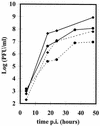An avirulent mutant of rabies virus is unable to infect motoneurons in vivo and in vitro
- PMID: 9420224
- PMCID: PMC109373
- DOI: 10.1128/JVI.72.1.273-278.1998
An avirulent mutant of rabies virus is unable to infect motoneurons in vivo and in vitro
Abstract
An antigenic double mutant of rabies virus (challenge virus standard [CVS] strain) was selected by successive use of two neutralizing antiglycoprotein monoclonal antibodies, both specific for antigenic site III. This mutant differed from the original virus strain by two amino acid substitutions in the ectodomain of the glycoprotein. The lysine in position 330 and the arginine in position 333 were replaced by asparagine and methionine, respectively. This double mutant was not pathogenic for adult mice. When injected intramuscularly into the forelimbs of adult mice, this virus could not penetrate the nervous system, either by the motor or by the sensory route, while respective single mutants infected motoneurons in the spinal cord and sensory neurons in the dorsal root ganglia. In vitro experiments showed that the double mutant was able to infect BHK cells, neuroblastoma cells, and freshly prepared embryonic motoneurons, albeit with a lower efficiency than the CVS strain. Upon further incubation at 37 degrees C, the motoneurons became resistant to infection by the mutant while remaining permissive to CVS infection. These results suggest that rabies virus uses different types of receptors: a molecule which is ubiquitously expressed at the surface of continuous cell lines and which is recognized by both CVS and the double mutant and a neuron-specific molecule which is not recognized by the double mutant.
Figures





References
-
- Anilionis A, Wunner W H, Curtis P J. Structure of the glycoprotein gene in rabies virus. Nature (London) 1981;294:275–278. - PubMed
-
- Bai X H, Warner C K, Fekadu M. Comparisons of nucleotide and deduced amino acid sequences of the glycoprotein genes of a Chinese street strain (CGX89-1) and a Chinese vaccine strain (3aG) of rabies virus. Virus Res. 1993;27:101–112. - PubMed
-
- Bataillé, S., P. Portalier, P. Coulon, and J. P. Ternaux. Influence of acetylcholinesterase on embryonic spinal rat motoneuron growth in culture: a quantitative morphometric study. Eur. J. Neurosci., in press. - PubMed
-
- Benmansour A, Brahimi M, Tuffereau C, Coulon P, Lafay F, Flamand A. Rapid sequence evolution of street rabies glycoprotein is related to the highly heterogeneous nature of the viral population. Virology. 1992;187:33–45. - PubMed
Publication types
MeSH terms
Substances
LinkOut - more resources
Full Text Sources
Other Literature Sources

